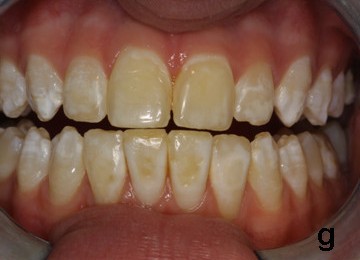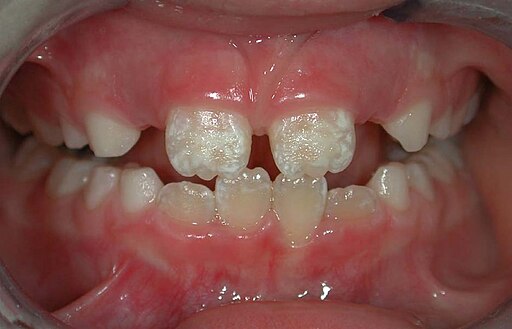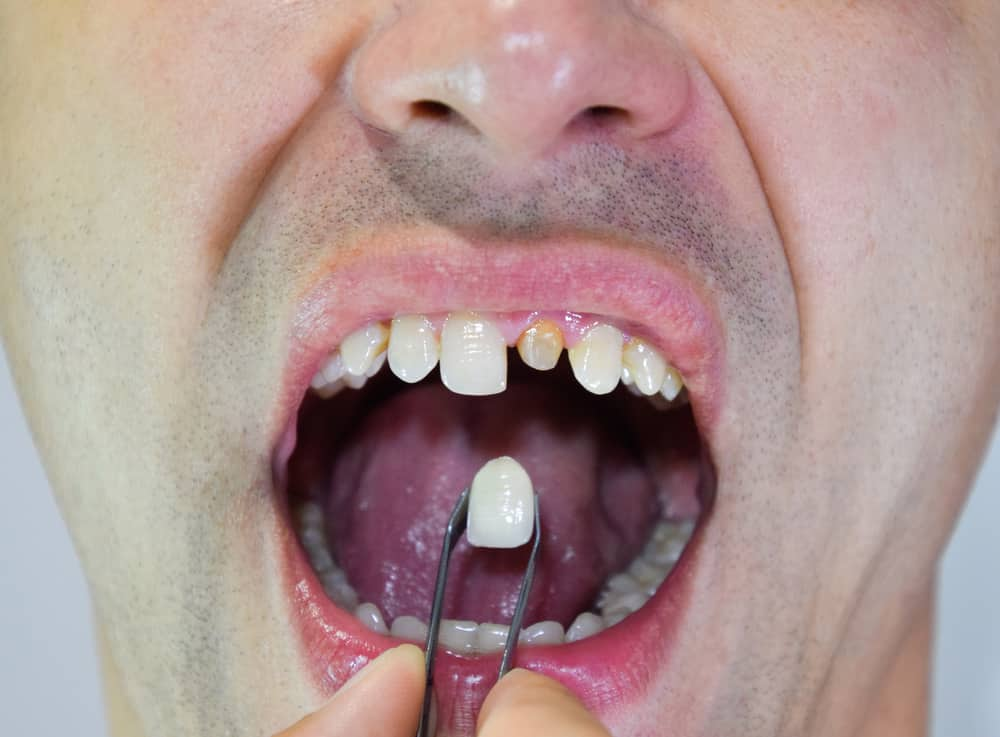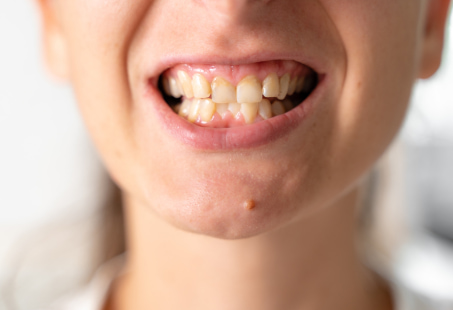Discoloured yellow spots on teeth are not only an aesthetic concern but can also indicate serious health problems. You may acquire them or develop them as a part of a genetic condition.
Unfortunately, sometimes, these spots can be permanent, and treatments like teeth whitening might not be enough to get rid of them. Depending on the underlying cause, however, there are multiple treatment options that you can consider to improve the overall appearance and, in some cases, even the functioning of your teeth.
In this guide, you’ll learn more about what causes yellow spots on teeth, whether or not you can expect them to go away, and what you can do about them.
What Are The Yellow Spots On My Teeth?
The yellow spots on your teeth can develop due to a number of reasons, such as:
- Reduced calcium in the teeth
- Excessive intake of fluoride
- Abnormality in the formation of the enamel
- Certain health problems and medical treatments
Let’s take a closer look at some of the health problems that might leave such spots on your teeth:
Hypocalcification
Hypocalcification refers to the poor mineralisation of the teeth’s enamel, specifically with regard to the reduced presence of calcium. Considering that the enamel is composed of calcium phosphate, its insufficiency can weaken the enamel, making your teeth more vulnerable to tooth decay. Teeth can also feel more sensitive and have a chalky appearance. Additionally, hypocalcification can result in the formation of spots on teeth, which can be yellow, brown or white in colour.

One of the causes of hypocalcification is amelogenesis imperfecta, which is an inherited disorder that results in abnormalities in the enamel of the baby and permanent teeth. It has been said that fever, antibiotics during childhood, or childhood diseases can cause hypocalcification, but as per a 2014 study in Inside Dentistry, this usually isn’t the case. If there’s no genetic cause, it’s considered “idiopathic,” meaning the cause remains unknown.
Fluorosis
According to the National Cancer Institute (NCI), dental fluorosis is a condition that results from overexposure and subsequent ingestion of fluoride, causing:
- “White streaks to brown stains” to form on the teeth
- “Cracks or pits” in the enamel
The colour of the stains is also described as being yellow-brown. The notable thing, however, about this condition is that it affects children who are 8 years old or younger when their teeth are still developing. There can be different sources of fluoride, such as in toothpaste or drinking water with excess fluoride. Unfortunately, once your child develops these spots, they’ll stay there permanently.
Molar-Incisor Hypomineralisation
Molar-incisor hypomineralisation (MIH) is another dental defect, which as the name suggests, refers to a deficiency of mineral in the enamel. As reported in a 2018 study published in the British Dental Journal, the condition leads to discolouration and fracturing of the affected teeth. The researchers also reported that while it was first believed to affect permanent molars and incisors (hence the name), it’s since been found to affect any tooth whether it’s baby or permanent.

Other than weakening teeth, this condition can also leave yellow, brown or white patches on the teeth and make them more sensitive. According to the NHS, the cause of MIH is yet not known, however, the following are believed to be responsible:
- Severe illness
- Fever
- Environmental pollutants
- Low weight at birth
- Antibiotics
Unfortunately, this condition can also very severely damage the teeth. Teeth can easily break, and they’re also more vulnerable to decay. So, it’s not simply an aesthetic issue. There are, however, several treatments that can help.
Enamel Hypoplasia
Enamel hypoplasia is another condition that affects the development of the enamel, leaving it deficient or defective. In addition the leaving yellow, brown or orange spots on the teeth, this condition can also result in the formation of pits and grooves on the tooth’s surface. Such teeth can also be softer, weaker and more prone to decay.

As far as the causes of this condition are concerned, both hereditary (e.g. amelogenesis imperfecta, Heimler syndrome, otodental syndrome, etc.) and environmental factors (e.g. infection, trauma, nutritional issues, celiac disease, etc.) are blamed, along with maternal health (e.g. drugs, smoking, fever, etc.) during pregnancy.
Medical Treatments
Certain medications are known to stain the teeth, such as tetracyclines, which can stain both primary and permanent teeth. Doxycycline, which is another antibiotic, is also reported to stain the teeth. Other medications like antihistamines and those used to treat high blood pressure are reported to do the same. Certain chemical ingredients found in dental health products can leave stains on the teeth.
One example of it is cetylpyridium chloride, which can be found in mouthwashes. According to the American Dental Association (ADA), this ingredient can stain the teeth, tongue, and/or any dental restorations in your mouth brown. A 2019 case report published in The Journal of Clinical and Aesthetic Dermatology also reported “yellow-brown staining” from this ingredient, which happens when it reacts with certain compounds found in food and drinks.
Do Yellow Stains On Teeth Go Away?
In order to understand whether or not yellow spots on teeth go away, you should know that there are two types of teeth discolouration: extrinsic and intrinsic. Extrinsic is when the outside of the tooth is affected by factors such as:
- Smoking
- Teeth-staining foods (like curries, teas, soy sauce)
- Plaque
- Ageing
Intrinsic is when the inside of the tooth is affected possibly by factors such as:
- Antibiotics
- Fluorosis
- Problems in the development of the teeth
- Injury
Your at-home dental hygiene routine, or depending on the severity of the stain, teeth whitening and/or scale and polish might help with the extrinsic stains. However, stains that develop due to structural changes or problems with the tooth are unlikely to be brushed or flossed away. They usually require some help from cosmetic dentistry.
How To Get Rid Of Yellow Spots On Teeth?
To get rid of the yellow spots on your teeth, you must first get a professional diagnosis for their underlying cause. The recommended treatments can vary accordingly.
Starting from hypocalcification, the treatment for the condition can depend on how severe your problem is. If it’s mild, your dentist may recommend the use of certain toothpastes to help with the teeth’s calcium content. Fluoride treatments might also be recommended. However, if the tooth has experienced significant decay, you might need a dental crown or some other restoration.
In the case of fluorosis, treatments may include:
- Microabrasion
- Polishing
- Whitening
- Composite bonding
- Veneers
- Crowns

Again, how severe the problem is will impact your final treatment plan. Molar-incisor hypomineralisation’s treatment options might include:
- Microabrasion
- Fluoride treatment
- Sealants
- Composite resin
- Fillings
- Veneers
- Crowns
- Tooth extraction
For enamel hypoplasia as well, the treatment options may be similar, including:
- Microabrasion
- Sealants
- Filling
- Whitening
- Fluoride treatment
- Composite bonding
- Veneers
- Crowns

In any case, it’s also important that you take good care of your teeth by brushing twice a day and flossing.
Conclusion
Yellow spots on teeth can look quite unsightly, especially if they’re on the front teeth. However, having these spots may also be a sign of structural weakness in your teeth, which might make them more vulnerable to chipping and decay.
There are different reasons why these spots can form. They can be acquired through certain environmental factors. On the other hand, sometimes, with genetics involved, you might not be able to prevent them.
Fortunately, there are different treatment options that might be able to help you. However, first and foremost, before anything, you must consult a board-certified medical doctor for a diagnosis and an effective treatment plan.
Reviewed and approved by Dr Izbel Aksit

